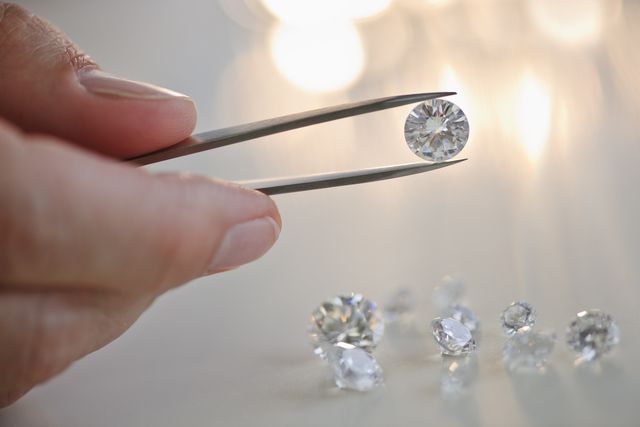If you've shopped for jewelry lately — especially engagement rings — you've surely noticed a growing number of options when it comes to your choice of stone. There's moissanite, an equally tough diamond simulant made from silicon carbide; diamonds, of course, the long-standing standard for center stones; and now lab grown diamonds, which are stones grown, well, in a lab.
Folks who've fetishized diamonds as a symbol of unity and endurance might balk at lab grown diamonds, under the assumption that they're either fake or of lesser quality. In fact, though, it's quite the opposite — on both counts. To better understand the differences between lab grown diamonds and natural ones, we spoke with stone expert Ryan Atlas, the Director of Product Development at Brilliant Earth, a jewelry company that specializes in ethically (and sustainably) sourced diamonds of both varieties.
Lab Grown Diamonds vs. Natural Diamonds
"Companies actually worked to create the first batch of lab-grown diamonds in the 1950s," Atlas says. It was GE that did it first, under a program called Project Superpressure. "However they did not become commercially available until later on in the late 1980s. It wasn’t until more recently that the value of lab-grown diamonds improved in terms of evaluating quality and price based on the 4 C’s (Carat, Clarity, Cut, and Color)."
What Is a Lab Grown Diamond?
"Lab grown diamonds are grown in highly controlled laboratory environments using advanced technological processes that duplicate the conditions under which diamonds naturally develop when they form in the mantle, beneath the Earth’s crust. These lab-created diamonds consist of actual carbon atoms arranged in the characteristic diamond crystal structure. Since they are made of the same material as natural diamonds, they exhibit the same optical and chemical properties."
Where to Buy Lab Grown Diamonds
A growing (pun intended) number of jewelers are using lab grown diamonds exclusively, or, at the very least, stocking equal amounts of both lab grown and natural diamonds. Often, they cost less, too, but be careful you're not being tricked. Moissanite, for example, may look a lot like diamond, but it isn't. The easiest way to know what you're buying is to demand certification and get it third-party tested.
How Are Diamonds Grown in a Lab?
"Lab grown diamonds are created from the tiny carbon seeds of pre-existing diamonds. Lab created diamonds are grown through a sustainable process using chemical vapor deposition (CVD), making it easier to keep up with demand without sacrificing quality or engaging in harmful processes or conflicts."
How Long Does it Take to Grow Diamonds in a Lab?
"Natural diamonds take hundreds of millions of years while lab grown diamonds take a matter of weeks."
Are Lab Grown Diamonds Real?
"A man made lab-grown diamond can only be distinguished from natural diamonds using specialized equipment that can detect the minor differences in trace elements and crystal growth. A diamond that is created in a lab is just as real as a mined diamond. They have the same physical and chemical properties and are grown under the same temperature and pressure conditions."
Do Lab Grown Diamonds Cost More?
"Lab created diamonds offer excellent value, and are more affordable than natural diamonds of comparable size and quality."
Why Would Someone Choose Lab Grown Over Natural?
"Lab created diamonds are often of better quality due to the highly controlled environment and fully monitored process," he says. Brilliant Earth offers both and believes it is important customers have the option, even if lab grown diamonds are more ethical.
"Some people like that lab diamonds have no mining association and some really like the history and romance of natural diamonds. We want to provide conscious customers the opportunity to choose for themselves."


















